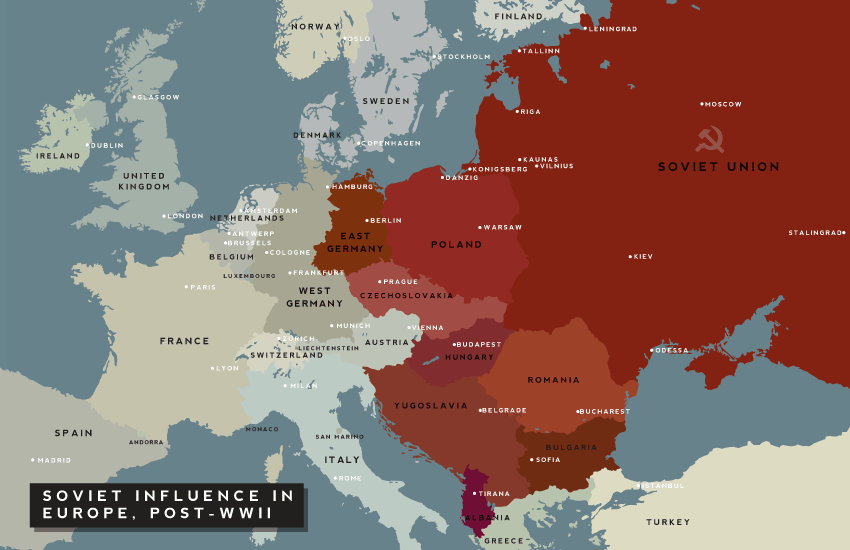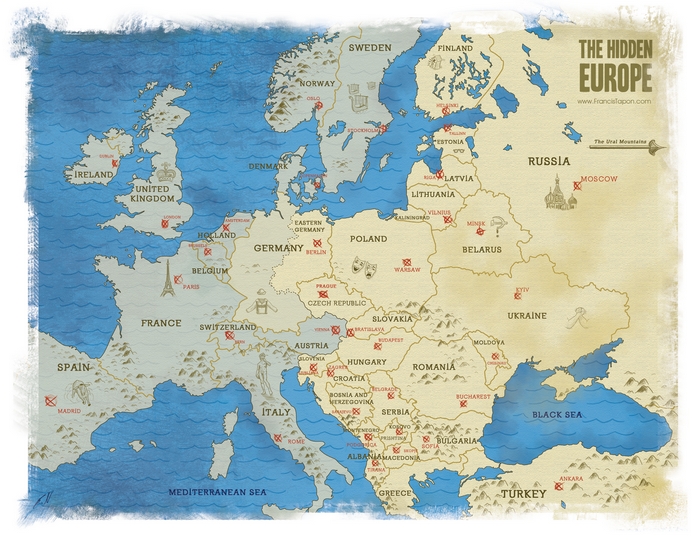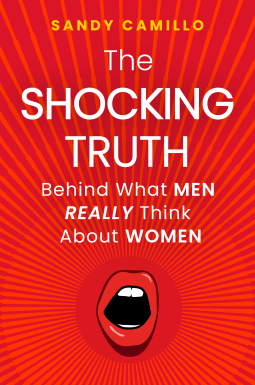 Asking, “Where is Eastern Europe?” seems as stupid as asking, “Who is buried in Grant’s tomb?”
Asking, “Where is Eastern Europe?” seems as stupid as asking, “Who is buried in Grant’s tomb?”
Obviously, Eastern Europe is in the eastern part of Europe.
However, where to draw that line is extremely controversial. Indeed, it’s hard to find two people who agree on which countries are in Eastern Europe.
Back in the good old Cold War days, defining Eastern Europe was easy: it was made up of all those losers who were on the wrong side of the Iron Curtain (see map). Eastern Europe had those backward, communist countries which were frozen in the Stone Age.
Because the world had such a low opinion of Eastern Europe, nowadays nobody wants to admit that they live there. For example, let’s just look at the Baltic countries. I’ve met Estonians who assert that they are in Northern Europe, Latvians who proclaim that they are in Central Europe, and Lithuanians who argue that they are in Western Europe!
If you were to believe everyone you talked to, you would conclude that Eastern Europe just doesn’t exist! When pressed, Eastern Europeans admit that Eastern Europe exists, but they all believe that the region starts just east of whatever country they happen to live in. I like this definition. My father was French, so Eastern Europe, for me, starts in Germany. Sorry, Germans.
If you’re European, it’s time to review Geography 101.
Any territory can be divided in a number of ways. For instance, you can divide it east-west and/or north-south. If you like, you can create a central region. To have even more granularity, you can create a northeast region, a southeast region, and so on.
However, sometimes people don’t want all those options. They just want a simple binary division (thereby eliminating the concept of a central region).
For example, if you want to divide the US with a north-south split, you would probably use the old Civil War dividing lines. If you want a simple east-west split, you would use the Mississippi River, even though it’s an imperfect split.
Chicago boys may dislike being called an Eastern American just as a Hungarian might dislike being called an Eastern European. They both would yell, “We’re Central, not Eastern!” Similarly, someone from Montana might say, “I’m not in the Western US, I’m in the Northern US!” They would all have a good point.
However, if central and northern are not options (and they are not when you divide a territory with a simple east-west split), then you must choose a side. You might not like east-west splits, but there’s nothing evil about dividing any region that way. So get over it.
However, we still have the challenge of deciding where that east-west line should be. Let’s be scientific about it. Geologists agree that Eastern Europe ends at the Ural Mountains, which lie hundreds of kilometers east of Moscow. It’s 5,200 kilometers (3,250 miles) from Lisbon, Portugal to Perm, Russia (a city next to the Urals). The halfway point is Wrocław, a Polish city near the German border (see Google map below).
If you extend a north-south line through Wrocław, it would cross the Czech Republic, Austria, and western Croatia. Only Slovenia would find itself on the west side of that dividing line (you can hear the Slovenians cheering now). In short, this 50/50 geographical split results in an east-west border that is quite close to the Cold War dividing line.
Another way to solve this tedious question is to learn where experts say is Europe’s geographic center. Wherever that point is, we could project a north-south line across it, thereby clearly marking Europe’s east-west division.
Unfortunately, geographers can’t agree on all the edges of Europe, so they can’t agree on its exact center. Geographers have placed Europe’s center as far west as Dresden (Germany), as far east as Rakhiv (Ukraine), and as far north as Estonia’s island of Saaremaa.

War is God’s way of teaching Americans geography. — Ambrose Bierce
Before we invest too much time finding the perfect 50/50 split, let’s remember that many east-west (or north-south) divisions are asymmetrical. For example, about two-thirds of America rests on one side of the Mississippi River. Russia’s east-west line is the Ural Mountains, even though that results in a 75/25 split. Cities often have artificial and arbitrary east-west divisions that are hardly symmetrical. They might be based on a railway line or a river. Therefore, even if you play with a world map to “prove” that Europe’s perfect 50/50 east-west split lies east of Romania, it doesn’t mean that’s where the division should be.
There’s another good reason to use the old Cold War dividing line. History shapes who we are. Whether Eastern Europeans like it or not, the communist experience is still in their collective memory. Those who are under 30 years old might yell, “But I don’t remember those days! I grew up with Western values!”
However, their parents and teachers drilled their local history and values into their children’s brains. It’s part of who they are. The legacy of slavery can still be felt in the southern regions of the US, even though slavery ended 150 years ago. Communism, in contrast, ended less than 25 years ago. Communism may have left Eastern Europe, but its long shadow is still there.
Finally, there’s one more thing that Eastern European countries have in common: they’re still relatively hidden. Of course, businesses and tourists have poured into the region ever since the Wall came down in 1989. However, the world is still far more familiar with Western Europe than Eastern Europe. Most people can explain the difference between Italy and Ireland; however, they’ll give you a blank look if you ask them to compare Slovenia and Slovakia.
In conclusion, for geological, historical, and even touristy reasons, I have defined Eastern Europe quite broadly. The Hidden Europe puts 25 countries in Eastern Europe. It includes:
- Western Russia
- Germany’s eastern half
- The ex-Yugoslav countries
It also includes three countries that few consider part of traditional Eastern Europe: Finland, Greece, and Turkey. Finland is east of Poland (and north of the Baltic), so geographically it certainly is in Eastern Europe. Greece is also geographically in Eastern Europe (it’s south of the Balkans). However, we will only examine the part of Greece that is most tied to the rest of Eastern Europe: Greece’s northern portion. Like Russia, most of Turkey is in Asia, so we will just look at its western side. In sum, I spent three years in 25 countries nearly 25 years after the Berlin Wall came down.
Americans may wonder why I’m taking so much time to define Eastern Europe. “What’s the big deal, anyway?” you may ask. “So you’re in Eastern Europe. So what? Who cares?”
Trust me. It’s a really big deal in this region. It’s a highly charged and emotional topic that sparks endless and explosive debates. If you want to make Eastern Europeans twitch and squirm, just tell them that they are from Eastern Europe. The only people who don’t seem to care are the Moldovans. They’re just happy that anyone knows that Moldova exists.
This article is an excerpt from the Introduction of The Hidden Europe: What Eastern Europeans Can Teach Us. The book is available at my shop! You might also enjoy this NYT article about "Where is Europe?"





